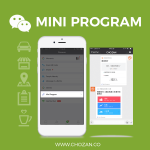WeChat has become a battleground for marketers in China. According to data from iiMedia Research, there were over 12 million official WeChat accounts in 2016. This is an increase of 46% from 2015 and the number is expected to reach 14 million this year. If each official account posts an article a day… 12 million articles are born! The field is crowded, the competition is fierce and readers don’t waste time on boring content.
How can you make your content stand out? You need viral marketing.
Viral marketing uses social networking services and other technologies to increase brand awareness, sales or marketing buzz through high-speed online word of mouth, similar to the way a virus spreads. The power of viral marketing is huge.
For example, if a brand shares an article with 100 people, then in four hours, 5% of them share it with another 20 people. 5% of them share the article with another 20 friends. Three days later, 1900 people will have seen it. This is just a small example.
Truly viral posts can garner huge share numbers in a shockingly short time.
WeChat’s Moments page is a perfect place for viral marketing. Most WeChat contacts are the user’s friends in real life so they see the content as more reliable, which results in a higher share rate.
But why do users share certain content?
What motivates users to share content? What are the incentives? Here are five characteristics of recent successful examples. Don’t try to include all of them in every article.
It’s better to go step by step and test your audience’s preferences before coming up with an overall strategy.
i. Evoke emotion
Content that can evoke emotion and deep feelings resonates. People experience lots of pressure in their daily lives related to work, finances, health, family, relationships, etc.
Content that expresses their unspoken words and thoughts and makes them feel less alone hits a nerve. Users like to share this kind of content.
For example, on April 21, Xinshixiang (新世相, WeChat ID: thefair2), an account known for its reviews of movies and TV shows, launched a campaign entitled “Escape from Beijing, Shanghai and Guangzhou (Season 2) (逃离北上广第二季)” on WeChat. They first launched the campaign in 2016 and created a sensation on Chinese social media and in the mainstream press. This time, Xinshixiang gave total 100 free flight tickets to participants who arrived at any airports of Beijing, Shanghai, and Guangzhou within four hours of the article’s publication.
The concept of escaping from big cities hit home with young people tired of the pressures of urban living. Most are from smaller places and came to big cities in the hope of finding opportunities. However, the crowded subways, endless overtime and unaffordable housing have gotten to them. Their dilemma: whether to stay or go.
The campaign offered them an opportunity to go, for a little while, and take a break. The article got over 1 million views and 6,000 likes.
ii. Be controversial
Controversial WeChat content often garners attention and can create wide-ranging discussions due to people’s strong and diverging opinions on the topic. This kind of content generally falls into one of two categories. One type is focused on an existing, usually recent, controversial incident. For example, when Bob Dylan won the Nobel Prize for Literature in 2016, people had strong opinions about whether he should be recognized as a singer or a writer. The other type of controversial content is based on value differences.
For example, some feel it’s best to marry for love while others feel that marriages arranged with simple compatibility in mind are best. Users love to argue for or against different positions, which quickly turns into marketing buzz and brand exposure.
Of course, great care has to be taken that the content isn’t so controversial as to shine a bad light on the brand or cause divisions among posters that are too deep.
Mimeng (咪蒙, WeChat ID: mimeng7), a top WeChat KOL, is a good example. Nearly all of her articles get over 100,000 views. She created her WeChat account in 2015 but already has millions of followers. In her articles, she always expresses her opinions in plain language.
For instance, one of her articles entitled “The Workplace Doesn’t Believe in Tears. Cry at Home. (职场不相信眼泪,要哭回家哭)” related several stories of the cruel realities of the workplace. In the article, she pointed out that each person has his or her own role. She feels that for interns, if the boss asks you to do odds and ends, like buying coffee or ordering food, you shouldn’t complain, because as an intern, your work is to save your superiors from these trivial matters.
After the article was published, dissenting voices emerged. Some people believe that learning new skills and getting hands-on work experience is the purpose of internships, rather than running errands such as buying food and coffee. The article generated heated discussion.
iii. Tell a story
A good story with clear structure has the power to touch an audience. Storytelling can be used to relate your brand story, your company culture, product descriptions and more.
When brands use stories to make WeChat content go viral, they should make sure of the following:
- Clarify the message you want to deliver. A story that carries too many messages will confuse users.
- Effective stories connect with the daily lives and experiences of readers.
iv. Trigger curiosity
The most effective way to arouse curiosity is to develop suspense or choose a compelling topic. Maintain suspense through the whole article to motivate users to read to the end. When the ending surprises users, they’re more likely to share the content.
This May, Pechoin, a Chinese skincare brand, cooperated with Jubuqihou (局部气候调查组, WeChat ID: jubuqihou), an agency, to publish an article which was one long picture.
The captivating article, entitled “1931”, tells the story of a beautiful agent on a secret mission in 1931. The picture first shows the agent going out equipped with a gun after finishing her makeup. With her identity hidden, she seems to be chasing something through the busy streets of Shanghai. A hook is created so readers want to keep scrolling to find out what happens. The artwork shows what Shanghai was like in 1931 with brief introductions of traditions of the time.
In the end, she finally finds her target and kills him. The victim is revealed and his name is “Time.” This is followed by a Pechoin ad. The obvious message is that Pechoin products can help you stay young and fresh. The underlying brand connection is that Pechoin was founded in 1931 in Shanghai.
Users liked this creative ad so much that many users shared it on their Moments pages. What’s more, compared to text, visual content is more attractive and easier to digest.
v. Be interactive
Interactivity is also an efficient incentive to encourage users to share content spontaneously. H5 pages are a good choice. WeChat content presented in an interactive way is much more appealing and enjoyable, which leads to increased user engagement.
Most interactive content in the form of H5 pages achieves millions of views in a short time.
In January 2016, an H5 page entitled “WeChat Story” created a sensation in WeChat’s Moments section. It showed the story of every user’s WeChat record in only three pages.
This included when they opened their account, how many Moments articles they’d posted, who their first WeChat contact was, how many red packets they’d received in the past year and so on. It was very popular, especially among young users.
Other suggestions on WeChat content
- Write catchy, clear titles. It’s the first thing users see and if they can’t understand it immediately, they’ll skip it. A good title motivates users to click.
- Content with 2000-3000 Chinese words is preferred to short paragraphs. Brands can also take other creative formats into consideration, such as H5 pages, well-crafted pictures and short videos.
- According to a recent report from investment bank Woodside Capital Partners, 37% of marketers believe partnering with KOLs is the best way to promote content.
How can you use these ideas to make your WeChat content go viral? Do you want to know more about successful WeChat content case studies?
Leave a comment below. We’re happy to answer your questions.
To get deeper insights into Chinese social media marketing and utilizing it to serve your business, join ChoZan, a training and resources platform for Chinese social media marketers.
Please follow our official WeChat account to get more updates about the latest news, feature updates and case studies.

Share this article on your favourite social media








